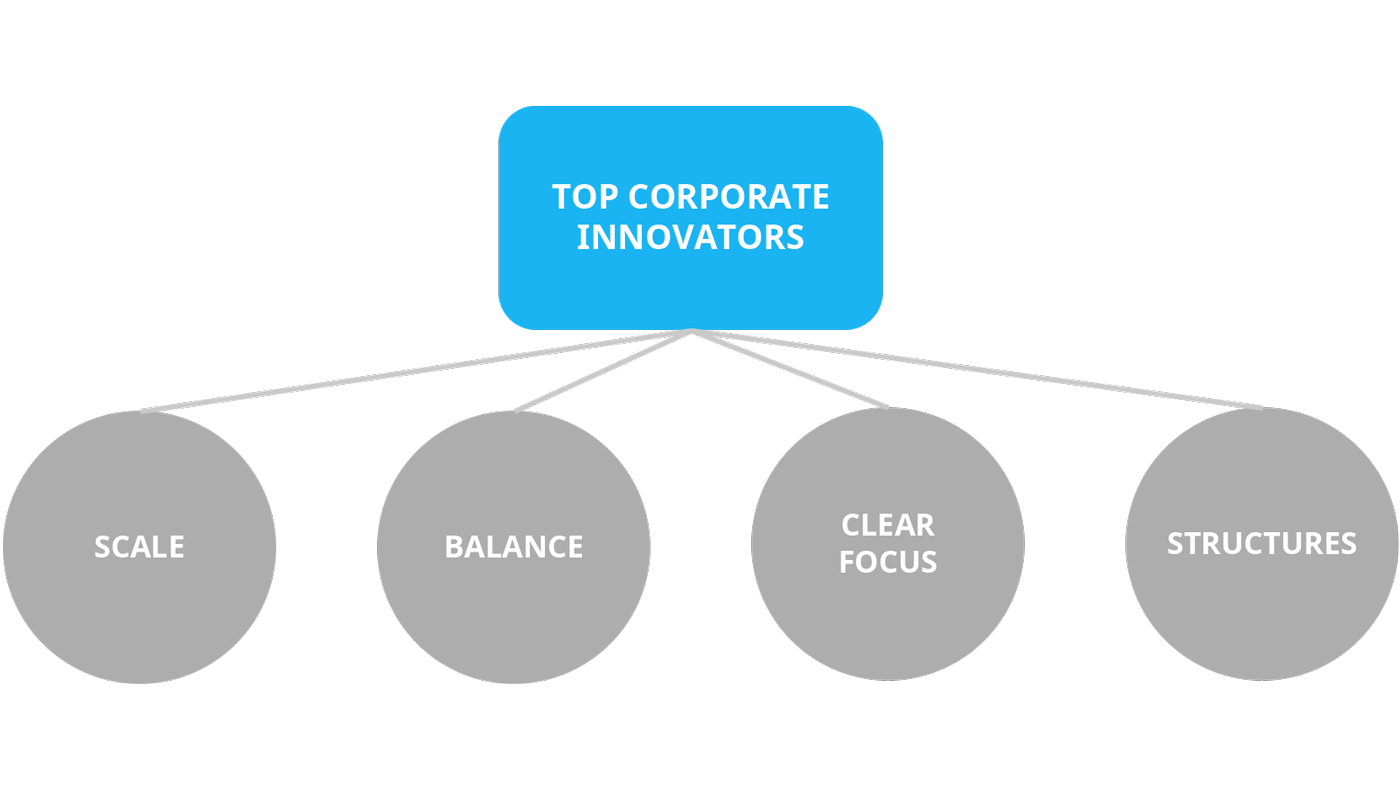What Do Top Corporate Innovators Get Right?
In our line of work, we get to talk with hundreds of leaders around the globe, and from virtually every industry.
Most of them seem to intuitively understand the importance of innovation, but there’s still a lot of fluff, ambiguity and uncertainty regarding innovation as a topic. As a result, most leaders aren’t seeing the results they were expecting for from innovation.
Given that we’re now on the verge of the next golden age of innovation, leaders have every reason to be anxious about the future of their organization.

Source: ARK Invest, used with permission.
However, the hype, as well as the lack of top management talent, has led to innovation leaders often being put in very challenging positions within their organization with little to no management support.
In working with hundreds of organizations on their innovation practices, as well as in doing research on other top innovators around the globe, we’ve identified certain patterns on how those top innovators, regardless of industry, are tackling these challenges today.
In this article, we’ll share those insights and will use them to try to predict what the future of corporate innovation will look like.

Table of contents
What are top innovators doing?
As soon as you start looking into corporate innovation, it's immediately clear that that there isn’t just a single correct way to innovate.
There isn’t just a single correct way to innovate.
For example, just by looking at Amazon, Apple, and Facebook, it’s obvious that they approach and lead innovation in quite distinct ways. What’s more, these methods are also different from those used by some of our most successful customers in more traditional industries.
The simplest way to try to categorize these approaches is to use a matrix that categorizes the strategy of the innovators based on two axes:
- Push – Pull
- Technology – Market

While it’s difficult to pinpoint where each of the aforementioned companies falls in the matrix, as they all have a hybrid approach to innovation with different parts of the organization innovating in slightly different ways, it can still be a useful exercise to improve our understanding of these differences.
As we can see from the matrix, even though Apple is all about customer experience, their approach to innovation is still very technology-driven and focused on launching and pushing new products and services they’ve been developing and refining for lengthy periods of time.
Facebook is almost a complete opposite of this. They focus on running hundreds of small tests to try and figure out what their users like and what creates value for their customers. Amazon uses a diverse mix of both of these approaches in different parts of their organization.
The philosophy and culture of these organizations are also quite different. The mantra at Facebook is to “move fast with stable infrastructure”, whereas Apple puts a lot more emphasis on creativity, craftsmanship and refinement.
While the culture might be a bit different, the Facebook approach is actually surprisingly close to what many of our most successful customers, even in traditional industries, are doing. They usually focus very heavily on the market and pull end of the spectrum by being very customer-oriented and agile in their innovation work.
Common themes among top performers
Despite these top innovators often working in very different ways, there are also a few key themes virtually all of them seem to share, which we'll introduce next.
This isn’t supposed to be a comprehensive list, but a summary of the aspects that we’ve identified as being the most prominent and having the biggest impact.

Scale
The first point, and maybe the most important one, is to understand that the best innovators don’t rely on a single R&D team or innovation lab for their results.
The best innovators, no matter how small or large they are, always have innovation happening on all levels and across the different parts of the organization.

Great innovation performance is usually a sum of many parts. It’s very difficult and rare for a large organization to be able to come up with an individual innovation that moves the needle significantly.
The reason is pure mathematics: growing 10% is much harder if your revenue is in the billions, than it would be if it were in the millions. As such, it’s simply not feasible to expect significant results quickly from a single team, department, or even innovation management process, let alone individual innovation.
It’s simply not feasible to expect significant results quickly from a single team, department, or even innovation management process, let alone individual innovation.
Decentralization and focus on scaling innovation work are absolutely essential for being able to produce predictable results that make a difference in the big picture.
What’s more, cultural transformation always requires a certain critical mass to overcome inertia. As long as innovation is just the job of a few select individuals or teams, you won’t be able to create an innovative culture, and without a pro-innovation culture, it will be difficult to sustain the results.
Balance
One of the challenges in innovation is the unpredictable nature and timeline of the work.
On one hand, you need to continuously invest in transformative innovation initiatives that could help drive the future growth and profitability of your organization in the long term.
On the other hand, you also need to keep improving your existing business to remain competitive and create short term financial results. If the business is in a bad financial position, there obviously won’t be any funds left to invest in innovation.
And even if there were, management and shareholders are often likely to lose patience with your innovation initiatives and cut funding for them if they aren’t seeing any tangible results.
 The best innovators find a way to balance their work between the incremental and disruptive, as well as the different time horizons to create a growing stream of innovation fuelling the business forward.
The best innovators find a way to balance their work between the incremental and disruptive, as well as the different time horizons to create a growing stream of innovation fuelling the business forward.
The 70-20-10 rule is a solid rule of thumb for most organizations. However, if you’re new to innovation, we usually recommend you start from the incremental and then gradually move to the more challenging and long-term disruptive projects as you acquire the skills, resources, and trust needed to succeed.
Clear focus
Let’s imagine that you’ve now tackled the first two factors and have a number of different business and technology units working on innovation.
Without strong leadership, a clear strategic focus, and strong alignment across the organization, it’s quite likely that the situation will only end up in chaos.
The best innovators find a way to set boundaries and focus efforts on pursuing strategically important goals. Because they do this, they are somewhat paradoxically able to allow their teams more freedom in pursuing those goals, which in turn helps them move faster, learn more and thus make more educated decisions.

For example, one of our biggest clients in a very competitive industry chose customer satisfaction as a key element of their new strategy a few years ago. They realized that a single innovation won’t fix the issue and knew that they needed to make tons of incremental improvements, as well as introduce certain new products and services to make their portfolio more competitive.
They then harnessed thousands of employees around the organization to try to come up with and implement ideas for improving the customer experience. A few years and a few thousand implemented ideas later, that focus has paid off big time. It’s helped turn the company around and started a new period of accelerating growth for the company.
There are of course certain situations where you might want to give completely free reins for your team, but at least in our experience, those cases are the exceptions and not an approach most organizations should actively pursue – unless their team is already exceptionally capable and disciplined.
Structures
The final piece to the innovation performance puzzle is the organization’s ability to systematically process and progress ideas.
In most cases, everyone in the industry has more or less the same innovative ideas. In the end, it’s the execution that makes the difference.

The key to do that, at scale, is to have the right structures and processes in place for identifying good ideas and progressing them, as well as ruthlessly killing the less promising ones.
In the end, it's the execution that makes the difference, and the key to do that at scale is to have the right structures and processes in place.
In practice that usually includes tools for collecting and managing ideas, an infrastructure for testing them, as well as clear processes for making the decisions.
What's more, given the need to innovate at scale, a single decision-making process simply won't cut it. The same process won't be suitable for all the different types of innovation and is also likely to lead to delays and biases in decision making.
For example, Facebook has built tools that allow anyone to easily test their idea with a limited subset of their users. If the results show an improvement in certain key metrics, the idea will be rolled out to the rest of the users. That allows them to continuously make small positive changes, the effects of which cumulate over time to make a big difference.
The best innovators always understand how these kinds of mature structures help them move faster and make smarter decisions.
What’s next?
Behind all the innovation hype, there is an uncomfortable reality. Innovation is no longer just a nice to have, it’s a necessity for organizations that are looking to survive, let alone thrive, in the coming decades.
To summarize the points I’ve made above, innovation should simply be a part of good management, not something you try to add to the mix after the fact.
Innovation should simply be a part of good management, not something you try to add to the mix after the fact.
We expect innovation, in one form or the other, to become an essential part of the core operations of most organizations in the near future. There are likely to be far fewer “labs”, hackathons, and innovation specialists, but many more people who are responsible for innovating around their own area of responsibility.
Succeeding at innovation takes a certain amount of skill, solid leadership, plenty of perseverance, and a bit of luck, but there isn’t anything magical about it.

Still, becoming a top innovator isn’t necessarily going to be easy. If it were, everyone would be one. Most organizations will, without a doubt, find the journey a long and arduous one, but it will certainly be worth the effort.
I’ll be looking into the specifics on how to get there in my next post.
In the meanwhile, if you’re looking to get a head start and start moving in the right direction, you might want to give Viima a try. Our software will help you get results quickly but will also evolve with you as you learn and move forward on your innovation journey.






